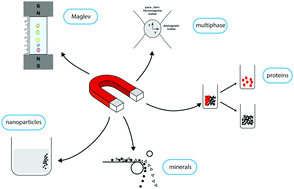当前位置:
X-MOL 学术
›
Chem. Soc. Rev.
›
论文详情
Our official English website, www.x-mol.net, welcomes your feedback! (Note: you will need to create a separate account there.)
Magnetic separation: its application in mining, waste purification, medicine, biochemistry and chemistry
Chemical Society Reviews ( IF 46.2 ) Pub Date : 2017-07-21 00:00:00 , DOI: 10.1039/c7cs00230k M. Iranmanesh 1, 2, 3, 4 , J. Hulliger 1, 2, 3, 4
Chemical Society Reviews ( IF 46.2 ) Pub Date : 2017-07-21 00:00:00 , DOI: 10.1039/c7cs00230k M. Iranmanesh 1, 2, 3, 4 , J. Hulliger 1, 2, 3, 4
Affiliation

|
The use of strong magnetic field gradients and high magnetic fields generated by permanent magnets or superconducting coils has found applications in many fields such as mining, solid state chemistry, biochemistry and medical research. Lab scale or industrial implementations involve separation of macro- and nanoparticles, cells, proteins, and macromolecules down to small molecules and ions. Most promising are those attempts where the object to be separated is attached to a strong magnetic nanoparticle. Here, all kinds of specific affinity interactions are used to attach magnetic carrier particles to mainly objects of biological interest. Other attempts use a strong paramagnetic suspension for the separation of purely diamagnetic objects, such as bio-macromolecules or heavy metals. The application of magnetic separation to superconducting inorganic phases is of particular interest in combination with ceramic combinatorial chemistry to generate a library of e.g. cuprate superconductors.
中文翻译:

磁选:其在采矿,废物净化,医学,生物化学和化学中的应用
永磁体或超导线圈产生的强磁场梯度和强磁场的使用已在许多领域得到应用,例如采矿,固态化学,生物化学和医学研究。实验室规模或工业实施涉及将大分子和纳米颗粒,细胞,蛋白质和大分子分离成小分子和离子。最有希望的尝试是将要分离的物体附着到强磁性纳米粒子上的那些尝试。在此,各种特定的亲和力相互作用用于将磁性载体颗粒附着到主要是生物学感兴趣的物体上。其他尝试使用强顺磁性悬浮液来分离纯反磁性物体,例如生物大分子或重金属。例如铜酸盐超导体。
更新日期:2017-07-22
中文翻译:

磁选:其在采矿,废物净化,医学,生物化学和化学中的应用
永磁体或超导线圈产生的强磁场梯度和强磁场的使用已在许多领域得到应用,例如采矿,固态化学,生物化学和医学研究。实验室规模或工业实施涉及将大分子和纳米颗粒,细胞,蛋白质和大分子分离成小分子和离子。最有希望的尝试是将要分离的物体附着到强磁性纳米粒子上的那些尝试。在此,各种特定的亲和力相互作用用于将磁性载体颗粒附着到主要是生物学感兴趣的物体上。其他尝试使用强顺磁性悬浮液来分离纯反磁性物体,例如生物大分子或重金属。例如铜酸盐超导体。

























 京公网安备 11010802027423号
京公网安备 11010802027423号